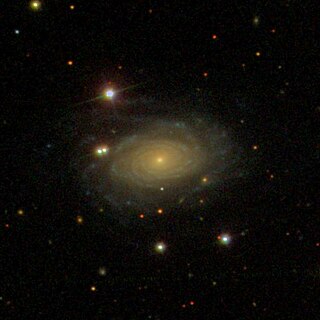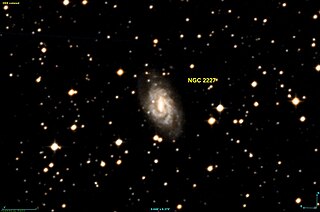
NGC 352 is a barred spiral galaxy in the constellation Cetus. It was discovered on September 20, 1784 by William Herschel. It was described as "pretty faint, small, irregularly extended" by John Louis Emil Dreyer, the compiler of the New General Catalogue; he also noted an "8th magnitude star 97 seconds of time to east" relative to the galaxy.

NGC 5775 is a spiral galaxy, a member of the Virgo Cluster, that lies at a distance of about 70 million light-years. Although the spiral is tilted away from us, with only a thin sliver in view, such a perspective can be advantageous for astronomers. For instance, astronomers have previously used the high inclination of this spiral to study the properties of the halo of hot gas that is visible when the galaxy is observed at X-ray wavelengths. It is a member of the NGC 5775 Group of galaxies, itself one of the Virgo III Groups strung out to the east of the Virgo Supercluster of galaxies.

NGC 3258 is an elliptical galaxy in the constellation Antlia. It is a member of the Antlia Cluster, which lies about 40.7 megaparsecs away. It was discovered on May 2, 1834 by John Herschel.

NGC 6850 is a barred lenticular galaxy in the constellation Telescopium, discovered by John Herschel in 1836.

NGC 3359 is a barred spiral galaxy located 59 million light-years from Earth, in the constellation of Ursa Major. It was discovered on November 28, 1793, by the astronomer William Herschel. The central bar is approximately 500 million years old.

NGC 251 is a spiral galaxy in the constellation of Pisces. It was discovered on October 15, 1784, by Frederick William Herschel.

NGC 252 is a lenticular galaxy located in the constellation Andromeda. It was discovered by William Herschel in 1786.

NGC 5002 is a Magellanic spiral galaxy in Canes Venatici. It was discovered by Heinrich d'Arrest in 1865. It is also known as MCG 6-29-51, PGC 45728, UGC 8254.

NGC 5559 is a barred spiral galaxy, located 240 million light-years away in the constellation of Boötes. It was discovered on April 10, 1785, by the astronomer William Herschel.

NGC 3697 is a spiral galaxy in the constellation of Leo. It was discovered on 24 February 1827 by John Herschel. It was described as "extremely faint, very small, extended 90°" by John Louis Emil Dreyer, the compiler of the New General Catalogue. It is a member of HCG 53, a compact group of galaxies.

NGC 6975, also known as NGC 6976, is a spiral galaxy in the constellation Aquarius. The object was discovered on 12 July 1864 by the German astronomer Albert Marth.

NGC 2227 is a barred spiral galaxy with a morphological type of SB(rs)c located in the direction of the Canis Major constellation. It was discovered on January 27, 1835, by John Herschel.

NGC 550 is a spiral galaxy in the constellation Cetus. It is estimated to be about 300 million light-years from the Milky Way and has a diameter of approximately 110,000 light years. The German-British astronomer William Herschel discovered it on 8 October 1785.

NGC 813 is a lenticular galaxy in the constellation Hydrus. It is estimated to be 390 million light-years from the Milky Way and has a diameter of approximately 140,000 ly. NGC 813 was discovered on November 24, 1834 by the British astronomer John Herschel.

NGC 996 is an elliptical galaxy of the Hubble type E0 in the constellation Andromeda. It is estimated to be 210 million light years from the Milky Way and has a diameter of approximately 75,000 ly. The supernova SN 1996bq occurred in this galaxy. NGC 996 was discovered on December 7, 1871 by astronomer Édouard Stephan.

NGC 941 is an intermediate spiral galaxy in the constellation Cetus. It is an estimated 16.83 MPc from the Milky Way and has a diameter of approximately 55,000 light years. The galaxies NGC 926, NGC 934, NGC 936, NGC 955 are located in the same sky area. NGC 941 was discovered by the astronomer William Herschel on 6 January 1785.

NGC 706 is a spiral galaxy located in the Pisces constellation about 230 million light years from the Milky Way. It was discovered by the German–British astronomer William Herschel in 1786.

NGC 644 is a barred spiral galaxy in the constellation Phoenix in the southern sky. It is estimated to be 270 million light-years from the Milky Way and has a diameter of approximately 130,000 light-years. Together with NGC 641, it probably forms a gravitationally bound pair of galaxies. The object was discovered on September 5, 1834 by John Herschel.

NGC 5557 is an elliptical galaxy in the constellation Boötes. It was discovered by William Herschel on May 1, 1785. The distance to NGC 5557 is not well known, but it is estimated to be about 127 million light-years away.

NGC 3613 is an elliptical galaxy in the constellation Ursa Major. It was discovered by the astronomer William Herschel on April 8, 1793. NGC 3613 is the center of a cluster of galaxies, and has an estimated globular cluster population of over 2,000.





















